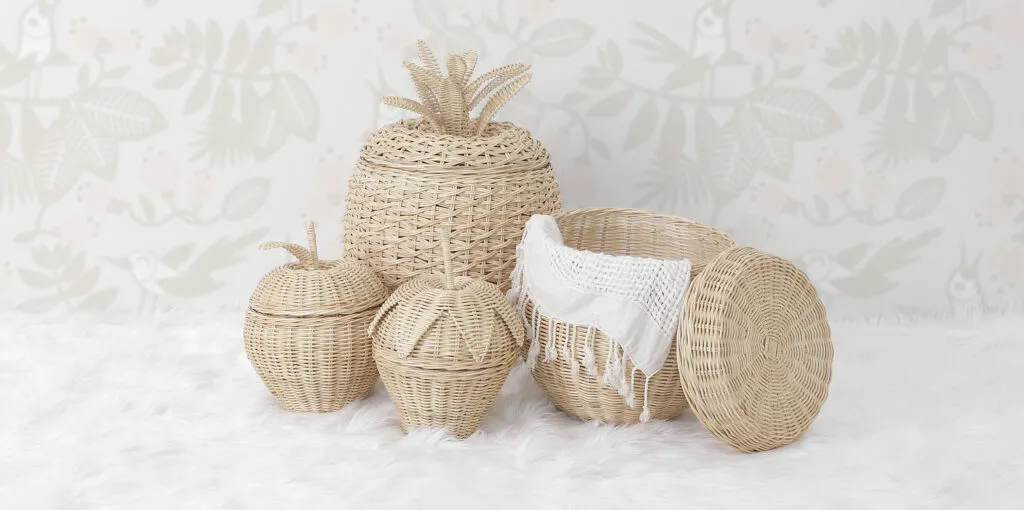Rattan baskets have stood the test of time not only as functional storage solutions but also as cultural artifacts and design icons. In a world increasingly filled with mass-produced plastic containers and disposable goods, the enduring charm of a handcrafted rattan basket speaks to our deep-rooted appreciation for nature, tradition, and aesthetic simplicity. From rural villages in Southeast Asia to luxury homes in the West, rattan baskets continue to captivate hearts with their natural textures, organic forms, and eco-friendly appeal.
A Brief History of Rattan and Basketry Traditions
The art of basketry dates back thousands of years and has been practiced in nearly every corner of the world. In tropical regions such as Indonesia, the Philippines, and Malaysia, rattan has long been the material of choice due to its abundance, strength, and flexibility. Unlike bamboo, which is hollow, rattan is a solid vine that climbs trees in the rainforests, making it particularly durable for weaving sturdy baskets.
Rattan baskets were initially used for daily utilitarian purposes such as carrying food, storing goods, and even fishing. Over time, these baskets began to reflect the cultural identities of their makers. Each region developed unique weaving patterns, techniques, and uses based on available resources, climate, and customs. In Indonesia alone, Cirebon, Kalimantan, and Bali each have their own distinct rattan weaving styles, often passed down from generation to generation.
With the arrival of global trade routes and colonial influence, rattan products began to find markets beyond their place of origin. European traders were fascinated by the intricacy and durability of rattan crafts, and by the 19th century, rattan furniture and baskets had become popular exports. Today, rattan remains a central component in the global home decor and furniture market, and baskets are among the most iconic and adaptable products in this category.
The Natural Appeal of Rattan
One of the most compelling reasons people choose rattan baskets over synthetic alternatives is the unique beauty of the material itself. Rattan has a warm, honey-toned hue that exudes a sense of organic comfort. Its natural grain and surface texture give each piece a character of its own, especially when handcrafted by skilled artisans. Unlike plastic, which can look uniform and lifeless, rattan’s slight imperfections and variations are celebrated as part of its charm.
Another attractive quality is the lightweight strength of rattan. It can be shaped, bent, and woven into intricate designs without compromising its structural integrity. This makes it ideal for creating baskets that are not only aesthetically pleasing but also highly functional. Whether used to store laundry, hold fruit, organize office supplies, or decorate a coffee table, rattan baskets are both practical and visually appealing.
Additionally, rattan is one of the most sustainable materials used in the furniture and decor industry. It grows quickly in tropical climates and can be harvested without killing the plant, allowing it to regenerate naturally. This sets it apart from hardwoods, which take decades to mature and require deforestation for harvesting. Choosing rattan products, especially those made by certified sustainable manufacturers, supports a more environmentally responsible lifestyle.
Types and Styles of Rattan Baskets
Rattan baskets come in an astonishing variety of shapes, sizes, and weaving styles. Some are large enough to hold blankets and toys in a living room, while others are small enough to serve as catch-alls for jewelry or toiletries. Open baskets with handles are popular in kitchens and entryways, while lidded rattan baskets are perfect for keeping items dust-free and organized in closets or pantries.
The style of weaving also greatly affects the final appearance of a rattan basket. Some baskets feature tight, uniform weaves that create a polished, symmetrical look, while others are loosely woven for a more rustic, natural aesthetic. Certain techniques like the coiling method produce thick, rope-like designs, while others use flat cane strips to form more refined, modern silhouettes.
Many contemporary rattan baskets blend traditional craftsmanship with modern design sensibilities. You might find baskets with dipped paint finishes, geometric patterns, leather handles, or even woven text labels. These designs cater to urban and minimalist tastes while preserving the authenticity of handwoven craftsmanship. Interior designers often use rattan baskets as decorative pieces in Scandinavian, coastal, bohemian, and farmhouse-style interiors.
How Rattan Baskets Are Made
The creation of a rattan basket is a labor-intensive process that begins with sourcing high-quality rattan. After harvesting, the rattan vines are cleaned, dried, and sometimes boiled to remove impurities and pests. They are then cut into strips or peeled into thinner layers, depending on the design requirements.
Next comes the weaving process, which is typically done by hand using age-old techniques. A skilled artisan begins by shaping the frame or base of the basket using thicker rattan stems for stability. Then, thinner strands are interlaced in various patterns around the frame, creating the basket’s body. Handles, lids, and decorative elements are added last, and the final product is often sun-dried or lightly sanded and varnished for smoothness and durability.
In some factories or cooperatives, this process is supported by basic machinery that aids in cutting and peeling rattan. However, the actual weaving is almost always done by hand to preserve the integrity and detail of the craft. In Indonesia and other major rattan-producing countries, basket-making provides employment for thousands of artisans, many of whom are women supporting their families through this traditional skill.
Cultural and Symbolic Value
Rattan baskets are not only functional objects but also carry cultural meaning in many societies. In Indonesian culture, for example, certain types of woven baskets are used in ceremonies, offerings, and traditional markets. They symbolize hospitality, abundance, and craftsmanship. In the Philippines, the “bayong” is a native woven bag often made from rattan or similar fibers, used for market shopping and daily errands. These items represent self-reliance and sustainability long before the zero-waste lifestyle became a global trend.
In African and Native American cultures, basketry has spiritual and artistic dimensions. Although they do not always use rattan specifically, their reverence for natural materials and handmade processes resonates with the philosophy behind rattan basketry. Owning a rattan basket, in this sense, becomes more than just a design choice—it becomes a celebration of global artisan heritage.
Modern Uses in Home and Lifestyle
Rattan baskets have evolved from simple storage items to multi-functional lifestyle pieces. In modern homes, they are used in every room—from the nursery to the bathroom, the pantry to the patio. In the living room, a large rattan basket beside the sofa can hold throw blankets, magazines, or firewood, adding texture and warmth to the decor. In the bathroom, smaller baskets keep towels, tissues, and toiletries neatly arranged. In the kitchen, rattan trays and bins provide elegant organization for fruits, bread, or spice jars.
Many people also use rattan baskets as planters or plant holders, taking advantage of their breathable structure to promote healthy root systems. When lined with plastic or waterproof liners, they make excellent homes for houseplants, combining functionality with natural aesthetics. Even pet owners have embraced rattan baskets as cozy beds for their dogs and cats, thanks to the gentle and non-toxic nature of the material.
Outside the home, rattan baskets are popular in hospitality and retail settings. Hotels use them to deliver towels and amenities to guest rooms. Spas use rattan trays for aromatherapy oils and skincare products. Boutiques use them as eco-friendly display containers. Their lightweight portability, resilience, and timeless look make them versatile assets in both commercial and residential contexts.
Sustainability and Ethical Sourcing
In an age when sustainability is no longer a choice but a necessity, rattan stands out as a material that aligns with eco-conscious values. Rattan grows rapidly—up to seven times faster than hardwood trees—and requires minimal water or chemical fertilizers. It thrives under the forest canopy, meaning it doesn’t contribute to deforestation but actually supports biodiversity by encouraging forest preservation.
However, not all rattan baskets are created equally. Ethical sourcing and responsible manufacturing play critical roles in ensuring that the industry benefits local communities and ecosystems. Certifications such as FSC (Forest Stewardship Council) and SVLK (Indonesia’s Timber Legality Assurance System) are indicators that the rattan was harvested legally and sustainably. These certifications also ensure that workers receive fair wages, operate in safe environments, and are trained in traditional techniques that preserve cultural knowledge.
Supporting artisan cooperatives and fair trade-certified producers is another way to promote ethical consumption. Many online platforms now offer transparency into their supply chains, showcasing the artisans behind each product. By choosing to buy from such sources, consumers can directly contribute to rural livelihoods while enjoying high-quality, handcrafted products.
Caring for Rattan Baskets
Although rattan is a hardy and resilient material, it does require some care to ensure longevity. Regular dusting with a soft cloth or brush prevents dirt from building up between the woven strands. For deeper cleaning, a damp cloth with mild soap can be used, followed by thorough drying in a shaded area to prevent mold or warping. Avoid placing rattan baskets in overly humid or wet areas, as moisture can compromise the fibers over time.
For storage purposes, keeping baskets away from direct sunlight will help prevent discoloration. If used outdoors, it’s best to bring them inside during rain or extreme weather. Occasionally, applying a thin layer of natural oil or furniture polish can enhance their sheen and protect against dryness or cracking. With proper maintenance, a rattan basket can last for decades while retaining its strength and elegance.
The Future of Rattan Baskets in Design and Commerce
As sustainability and natural aesthetics continue to influence interior design trends, rattan baskets are enjoying a major revival. From boho-chic apartments to minimalist Scandinavian homes, designers are embracing rattan’s texture and warmth as a counterbalance to sterile, industrial materials. The demand for handmade goods is also rising, as consumers seek out products with stories, origins, and human touch.
Online retailers, lifestyle brands, and artisan marketplaces are playing a key role in this resurgence. They bridge the gap between traditional craftsmanship and contemporary consumers by curating collections of high-quality rattan goods and offering global shipping. Social media platforms like Pinterest and Instagram have also amplified the visibility of rattan baskets, showcasing their versatility in real-life settings and inspiring creative uses.
With technology, the production and logistics of rattan baskets are also evolving. Designers are collaborating with artisans to develop new forms and hybrid materials, while supply chains are becoming more transparent and traceable. 3D modeling tools and design software now allow for precision prototyping of rattan products, without sacrificing the authenticity of handwoven construction. These innovations point toward a future where rattan baskets remain relevant, desirable, and impactful.
Why Choose Rattan Baskets Today
Choosing a rattan basket today is not merely a functional decision—it’s a statement of values. It means supporting handmade craftsmanship over industrial automation. It means choosing natural materials over synthetic waste. It means appreciating design that is both timeless and adaptable. It means honoring cultures that have preserved and passed down this knowledge for generations.
A rattan basket is more than just a container. It is a connection to the earth, to the hands that made it, and to the homes it inhabits. It represents a slower, more thoughtful way of living—one that values quality over quantity, tradition over trend, and sustainability over convenience.
As the world shifts toward more conscious consumption and holistic living, the humble rattan basket continues to weave its way into our lives—not just as a vessel, but as a symbol of resilience, beauty, and purpose.

